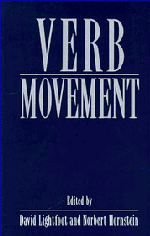Book contents
- Frontmatter
- Contents
- List of contributors
- Preface
- Verb movement: an introduction
- 1 Verb positions: evidence from Italian
- 2 Verb movement and word order in Arabic
- 3 Comments on the paper by Ouhalla
- 4 Some similarities and differences between Icelandic and Yiddish
- 5 Comments on the paper by Santorini
- 6 Finite verb movement in Scandinavian embedded clauses
- 7 Comments on the paper by Vikner
- 8 The Brythonic copula and head raising
- 9 A reinterpretation of evidence for verb movement in French
- 10 Two types of head movement in Romance
- 11 Comments on the paper by Roberts
- 12 Licensing heads
- 13 Comments on the paper by Koopman
- 14 Finiteness and head movement in early child grammars
- 15 Comments on the paper by Wexler
- References
- Index
8 - The Brythonic copula and head raising
Published online by Cambridge University Press: 03 May 2011
- Frontmatter
- Contents
- List of contributors
- Preface
- Verb movement: an introduction
- 1 Verb positions: evidence from Italian
- 2 Verb movement and word order in Arabic
- 3 Comments on the paper by Ouhalla
- 4 Some similarities and differences between Icelandic and Yiddish
- 5 Comments on the paper by Santorini
- 6 Finite verb movement in Scandinavian embedded clauses
- 7 Comments on the paper by Vikner
- 8 The Brythonic copula and head raising
- 9 A reinterpretation of evidence for verb movement in French
- 10 Two types of head movement in Romance
- 11 Comments on the paper by Roberts
- 12 Licensing heads
- 13 Comments on the paper by Koopman
- 14 Finiteness and head movement in early child grammars
- 15 Comments on the paper by Wexler
- References
- Index
Summary
Introduction
This study explores the syntactic consequences of the rather subtle variation in the copula that appears in the Brythonic Celtic languages. I begin by arguing in section 2 that there are in fact at least two Celtic copulas, a grammatical copula that simply spells out tense and agreement, and a substantive copula formed on a lexically listed verbal stem. This difference is reflected in the surface word order. The grammatical copula requires the predicate adjective (or nominal) to raise to tense and agreement so that it is positioned in initial position to the left of the subject. The substantive copula co-occurs with a predicative particle; the predicate adjective (or nominal) raises to that particle and appears to the right of the subject. The explanation I offer for these facts requires subjects of predicate adjectives and nominals to originate within VP-internal small clauses in contrast to subjects of unergative verbs that are VP-external in D-structure. In section 3 I examine the interaction of the copula with agreement in order to argue that the Breton copula forms an aspectual verb composed of the copula and a raised agreement prefix. The composition of this aspectual verb explains a number of its otherwise idiosyncratic characteristics. In addition, the construction suggests that external arguments of verbs are projected within an aspect phrase rather than VP-internally, confirming the tack taken to predicate adjectives and nominals. In section 4 I turn to consider the interaction of the copula with tense.
- Type
- Chapter
- Information
- Verb Movement , pp. 163 - 188Publisher: Cambridge University PressPrint publication year: 1994
- 4
- Cited by



